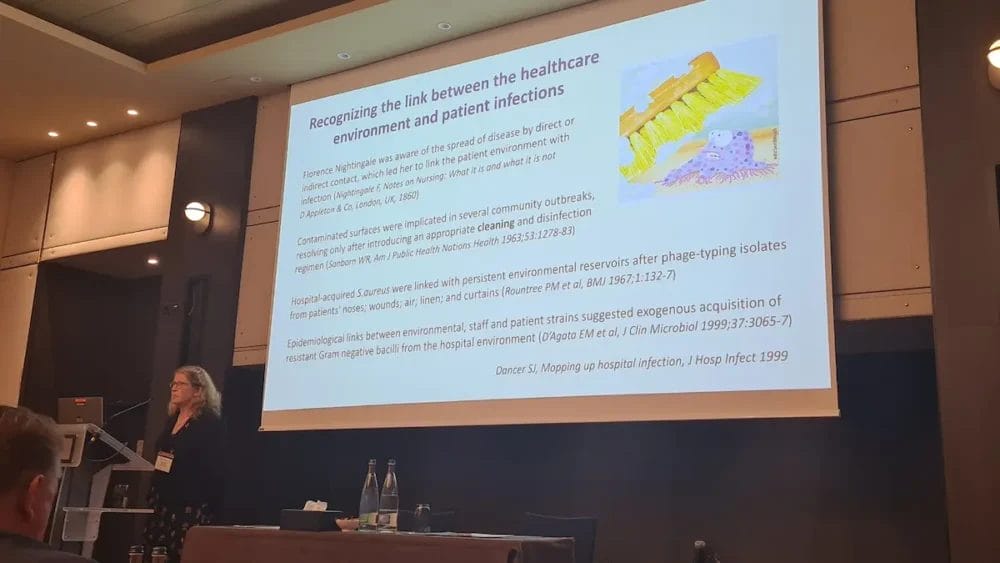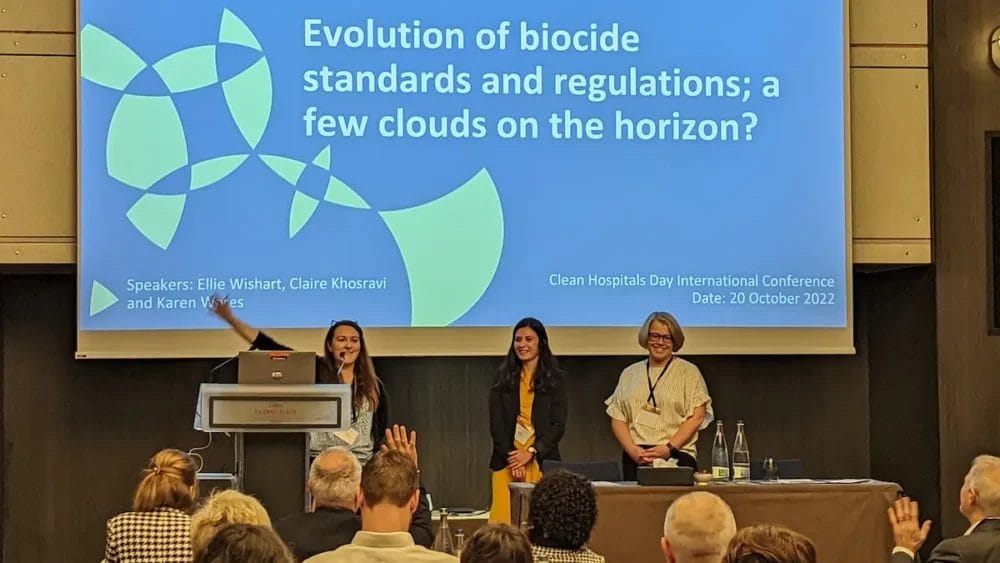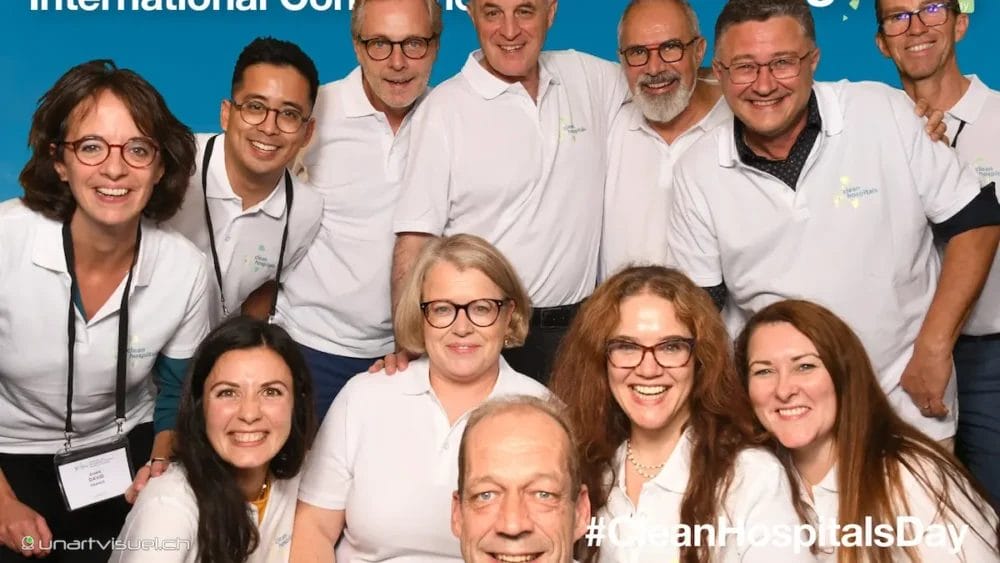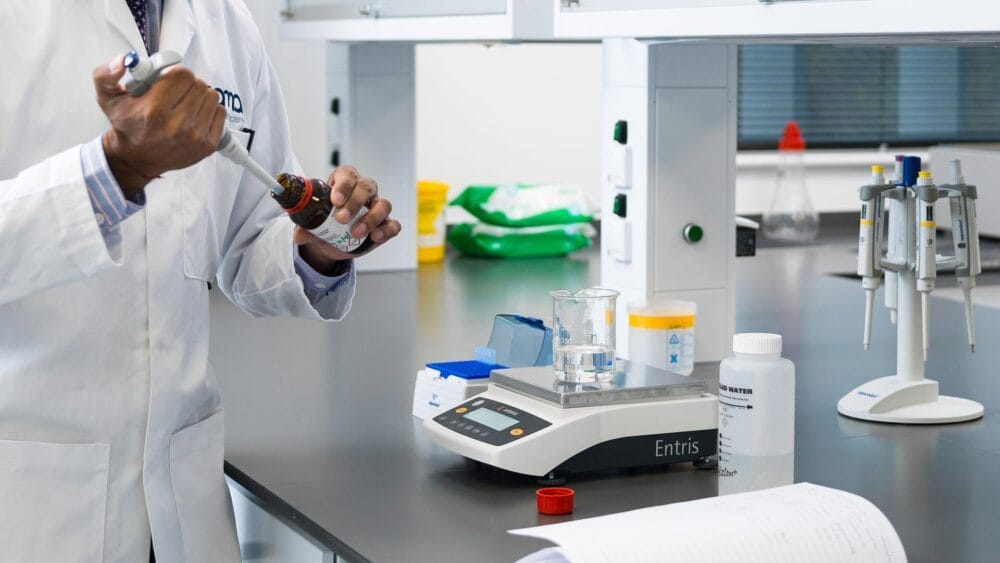Posted
25th October 2022
Events and Exhibitions
Karen Wares, our Clinical Director, reflects on her highlights from the 3rd Clean Hospitals Day International Conference.
The Clean Hospitals Day International Conference met face to face in Geneva, on the 20th October bringing together 129 professionals from 19 countries including Infection Control Practitioners, Environmental Hygiene Specialists, healthcare workers, and industry stakeholders.
What is Clean Hospitals Day?
Clean Hospitals Day encompasses all components of healthcare environmental hygiene including surface cleaning and disinfection, air control, waste management, sterilisation and reprocessing, water control, automated disinfection technologies, and more. The 20th of October is now recognised as #CleanHospitalsDay for everyone working in healthcare environmental hygiene and for those affected by it.

Dr. Stephanie Dancer’s opening session
Dr. Stephanie Dancer started her session with recognition that if you’d asked her 25 years ago if she’d be attending a conference purely focused on clean hospitals, she would have laughed! She summarised the links between the healthcare environment and patient infections from Florence Nightingale’s notes on nursing in one of her own publications. She also discussed that making the cleaning process more accessible improves cleaning frequency and effectiveness. Both Dr. Dancer and Consultant Practitioner Infection Prevention, Tracey Gauci, reiterated the importance of one wipe, one surface, one direction and the ‘S’ shape pattern. Dr. Dancer summarised advocating that one of the most important people you should ask about hospital cleanliness is the patients.

The evolution of biocide standards and regulations
The second session was a collaboration with myself and fellow Clean Hospital Partners Claire Khosravi from Diversey and Ellie Wishart from Ecolab. Together, we discussed the evolution of biocide standards and regulations.
Biocide Product Regulation (BPR) is concerned with the approval of biocidal active substances and authorisation of biocidal products in European Union. Currently, there is a mixture of BPR approved active substances in use in the EU and many of those awaiting assessment and approval. We discussed how BPR has two major defining purposes through applying the same set of rules across all of the European Union:
1. To ensure that products are safe (for the user & for the environment)
2. To ensure that products are effective against the target microorganisms
This process results in a more centralised authorisation and approval process for biocidal products at a European level and aims to harmonise the market. Due to the increased requirements on human and environmental safety, the impact of this regulation is expected to result in a reduced number of products available. We discussed why disinfection tests are needed, the challenges of BPR, how to chose the right product and that BPR is an ever-changing and challenging regulation and how the industry play a key role in informing product application, clinical use and user perceptions.
Sustainability and IPC
Tracey Gauci took of the topical subject of sustainability which she reiterated means different things to different people from environmental sustainability, climate change, carbon emissions, greenhouse gas production, renewable energy, net zero and impact on health.
She discussed the growing concern about the exposure of healthcare support workers and cleaners to chlorine-based disinfectants during the pandemic, due to the national IPC policy. She discussed concerns such as lack of training & education, not following instructions for use, making up solutions in poorly ventilated areas, impact on respiratory health (not just for staff but patients too) and the impact of discharging chlorine solutions into the drains/waste water system. Tracey discussed the need for cleaning and disinfection products to be:
- Convenient & efficient: available at the point of care; combining cleaning and disinfection in one step – time efficient and enable a ‘clean between’ culture
- Effective: tested in an accredited laboratory to the appropriate standards.
- One wipe, one surface, one direction: reduce likelihood of transmission
Summarising that a truly biodegradable and compostable wipe that doesn’t compromise efficacy will take time.
Related article: Surface disinfectant wipes: are you asking the wrong questions?
Results from the healthcare environmental hygiene self-assessment
Scientific Lead for Clean Hospitals, Alexandra Peters, shared the results of the healthcare environmental hygiene self-assessment framework (HEHSAF) survey and discussed the importance of environmental hygiene for patients and the lack of guidelines and international standardisation. For her second talk she discussed a study by Widmer et al (2021) which focused on the long-term antimicrobial effectiveness of a silver-impregnated foil on high-touch hospital surfaces. A self-adhesive film containing silver ions was applied in patients room to overbed tables, bedside tables, patient chair arm rests, dining tables, toilet seats and toilet flush handles. The study found that there was significant reductions in total cell counts on the silver treated film vs control surfaces and reductions in clinically important pathogens.
See you next year!

I’m looking forward to the next Clean Hospitals Conference taking place on the 20th October 2023!
GAMA Healthcare is proud to be a Clean Hospitals Industry Partner. If you’d like to find out about other events the GAMA Healthcare team has attended, visit our Events and Exhibitions section on our blog.
SHARE THIS ARTICLE
Tags
Latest News
Introducing HEXI HUB: A seamless transition in our product line
We’re pleased to announce an update to our product offering…
Innovative solutions for tackling Carbapenemase-producing Enterobacteriaceae (CPE) at King’s College Hospitals
King’s College Hospital NHS Foundation Trust, one of London’s largest…
Gloves Off: reducing unnecessary plastic waste during environmental cleaning and disinfection
In this blog, Dr Phil Norville discusses the momentum-gaining ‘Gloves…
Gloves Off: Navigating SDS sheets and skin safety claims in environmental decontamination products
In this blog, James Clarke (Head of R&D, Science &…







